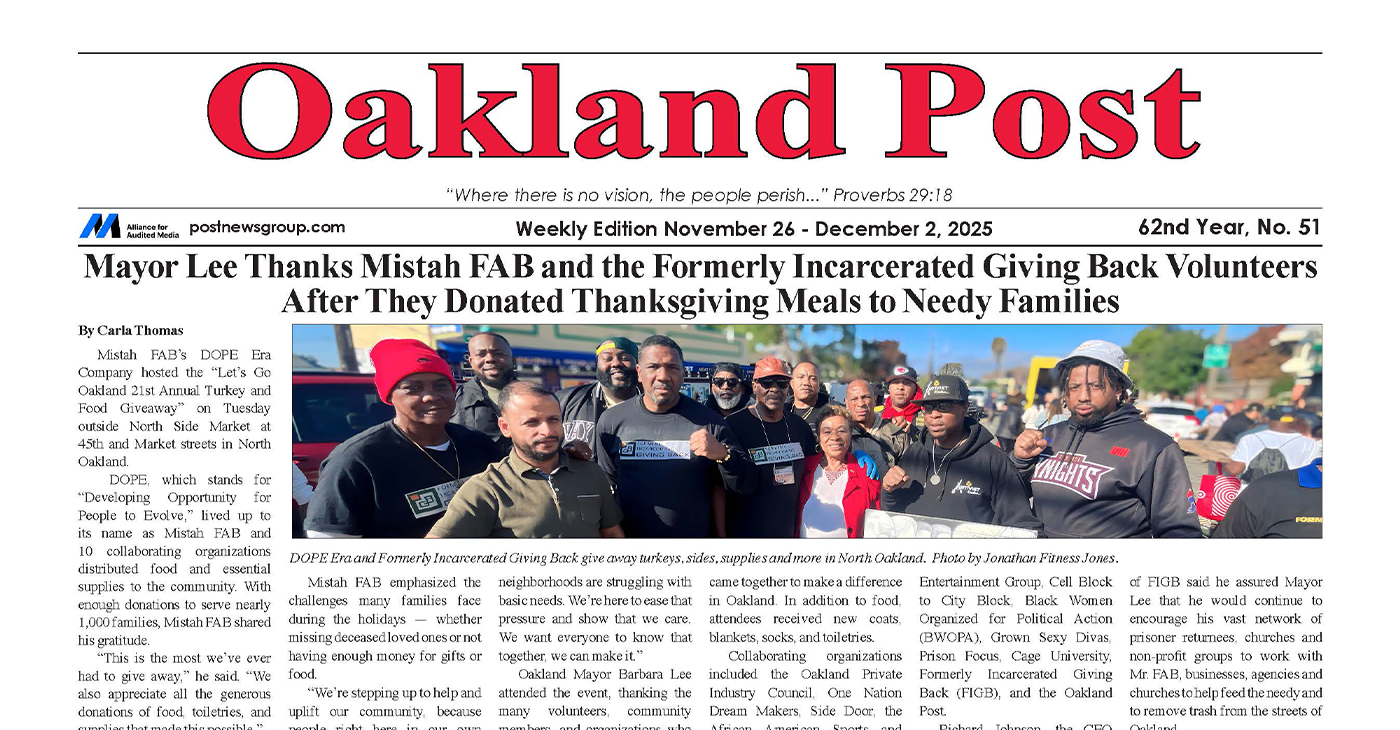Opinion
New Year’s Day is Also Emancipation Day

Our nation must fulfill the hopes unleashed by the Emancipation Proclamation
“Then Moses said to the people, ‘Commemorate this day, the day you came out of Egypt, out of the land of slavery, because the Lord brought you out of it with a mighty hand.’” — Exodus: 13:3.
African-American churches across the country, congregants gather to welcome the new year. They sing songs of freedom and overcoming. They testify to how far their faith has brought them and how much faith and courage they will need to face another year.
The tradition is called Watch Night, and it dates back 156 years to when President Abraham Lincoln set forth an essential document of freedom that most Americans have probably never read or thought much about: the Emancipation Proclamation.
The night before the proclamation went into effect on Jan. 1, 1863, free blacks in the North and their enslaved brothers and sisters in the South sat vigil in churches, in shabby slave shacks and in moonlit plantation woods to watch, pray and hope throughout the night to hear news that Lincoln’s promises of freedom had been officially issued and millions of our ancestors were legally free.
The president kept his word — although two more years of slaughter and civil war lay ahead. African-Americans emerged from that long night of waiting and watching with the right to pick up arms and join the military struggle to save the Union as soldiers and aboard “vessels of all sorts.” The proclamation declared that those enslaved in the Confederacy were now “forever free,” and the might of the United States government, “including the military and naval authority thereof, will recognize and maintain the freedom of such persons, and will do no act or acts to repress such persons, or any of them, in any efforts they may make for their actual freedom.”
The proclamation was the most consequential executive order in the history of the United States. It should be celebrated and honored.
For every American who cherishes freedom and democracy, New Year’s Day should mean far more than college bowl games and parades. The nation must revive and reclaim the true meaning and significance of January 1, Emancipation Day.
This January 1 is even more significant in that the year 2019 marks the 400th anniversary of the first documented African slaves’ forced arrival on the shores of the New World that was to become the United States of America. This anniversary year should be a time of commemoration and celebration, reflection — and action — on how far we have come and how far we must still travel to reach the mountaintop.
The journey from slavery to freedom was largely completed in 1865 with the adoption of the 13th Amendment. The march from freedom to equality is far from over.
I spent Christmas morning — as I have for more than 40 years — visiting and praying with the inmates and staff at Cook County Jail, the sprawling warehouse of the poor and dispossessed on the West Side of Chicago. As I looked out over the faces crowded into the jail’s gym, I saw that they were overwhelmingly black and brown.
Although African-Americans make up just 24 percent of the population of Cook County, nearly 74 percent of the jail’s population is black.
This story of inequality was four centuries in the making. It began in August 1619, when some 20 frightened, bewildered and beleaguered Africans arrived in Jamestown, Va., as prizes that had been pirated from Spanish ships on the open seas.
Even as revolutionary Americans rebelled against the British monarchy, declaring all men created equal, the founding fathers at the Constitutional Convention bowed to the South with three slave compromises that still haunt our nation: permitting the international slave trade; counting slaves as three-fifths of a person for congressional representation; and establishing the Electoral College, giving the South congressional representation disproportionate to its voter eligibility.
Yet in the darkness of chattel slavery, the enslaved were able to sustain enough of their humanity to maintain a light of hope for a better day, for freedom and for equality. African- Americans were able to see the dimly lit outlines of a more just social, economic and political order, even during slavery, apartheid and centuries of discrimination. But black people did not wait for freedom to fall from the sky. The Colonial era and beyond bristled with slave rebellions and resistance.
The lies, myths and insanity of white supremacy contaminated the soil and the soul of America. The Academy said African-American minds were inferior. The medical establishment said our bodies were inferior; the church, our morality. The banks determined that we were unworthy for loans or investment. These barriers have yet to be completely broken down. We are free but unequal. Yet still we rise.
History is an unbroken continuity that cannot be denied. Americans should not hide from the past nor engage in an extended exercise of rehashing 400 tragic years. Although there can be no plan for the future without comprehending the past, we cannot go forward while only looking backward.
2019 must be about the vision of a fully equal society.
In the coming year, we must set goals and a timetable for the most profound and in-depth corrective action program in history and show what true equality for all Americans means and looks like.
We must examine how much such repair will cost, what failure to repair has already cost, and the continuing cost to the nation in terms of human and economic underdevelopment if we fail to even the playing field for African-Americans and other people of color.
In 2020, there will be another presidential election. As the candidates campaign in the next two years, they must be challenged to share their vision of what an equal, nondiscriminatory, multiracial, multiethnic, multi-religious and nonsexist society looks like, and how they propose to take us there.
In the meantime, we the people — red, brown, yellow, black and white — must do what African-Americans have done for 400 years, from bondage to emancipation, from lynch mobs to great migrations, from the back of the bus to Rosa Parks, from the Rev. Dr. Martin Luther King Jr. on the balcony of the Lorraine Motel in Memphis to President Barack Obama on the balcony of the White House.
Keep hope alive.
Jesse L. Jackson Sr. (@ RevJJackson) is the founder and president of the Rainbow PUSH Coalition.
Advice
COMMENTARY: If You Don’t Want Your ‘Black Card’ Revoked, Watch What You Bring to Holiday Dinners
From Thanksgiving to Christmas to New Year’s Day, whether it’s the dining room table or the bid whist (Spades? Uno, anyone?) table, your card may be in danger.

By Wanda Ravernell
Post Staff
From the fourth week of November to the first week in January, if you are of African descent, but particularly African American, certain violations of cultural etiquette will get your ‘Black card’ revoked.
From Thanksgiving to Christmas to New Year’s Day, whether it’s the dining room table or the bid whist (Spades? Uno, anyone?) table, your card may be in danger.
It could take until Super Bowl Sunday for reinstatement.
I don’t know much about the card table, but for years I was on probation by the ‘Aunties,’ the givers and takers of Black cards.
How I Got into Trouble
It was 1970-something and I was influenced by the health food movement that emerged from the hippie era. A vegetarian (which was then considered sacrilegious by most Black people I knew) prepared me a simple meal: grated cheese over steamed broccoli, lentils, and brown rice.
I introduced the broccoli dish at the Friday night supper with my aunt and grandfather. She pronounced the bright green broccoli undone, but she ate it. (I did not, of course, try brown rice on them.)
I knew that I would be allowed back in the kitchen when she attempted the dish, but the broccoli had been cooked to death. (Y’all remember when ALL vegetables, not just greens, were cooked to mush?)
My Black card, which had been revoked was then reattained because they ate what I prepared and imitated it.
Over the decades, various transgressions have become normalized. I remember when having a smoked turkey neck instead of a ham hock in collard greens was greeted with mumblings and murmurings at both the dining room and card tables. Then came vegan versions with just olive oil (What? No Crisco? No bacon, at least?) and garlic. And now my husband stir fries his collards in a wok.
But No Matter How Things Have Changed…
At holiday meals, there are assigned tasks. Uncle Jack chopped raw onions when needed. Uncle Buddy made the fruit salad for Easter. My mother brought the greens in winter, macaroni salad in summer. Aunt Deanie did the macaroni and cheese, and the great aunts, my deceased grandmother’s sisters, oversaw the preparation of the roast beef, turkey, and ham. My father, if he were present, did the carving.
These designations/assignments were binding agreements that could stand up in a court of law. Do not violate the law of assignments by bringing some other version of a tried-and-true dish, even if you call it a new ‘cheese and noodle item’ to ‘try out.’ The auntie lawgivers know what you are trying to do. It’s called a menu coup d’état, and they are not having it.
The time for experiments is in your own home: your spouse and kids are the Guinea pigs.
My mother’s variation of a classic that I detested from that Sunday to the present was adding crushed pineapple to mashed sweet potatoes. A relative stops by, tries it, and then it can be introduced as an add-on to the standard holiday menu.
My Aunt Vivian’s concoctions from Good Housekeeping or Ladies’ Home Journal magazine also made it to the Black people’s tables all over the country in the form of a green bean casserole.
What Not to Do and How Did It Cross Your Mind?
People are, of all things holy, preparing mac ‘n’ cheese with so much sugar it tastes like custard with noodles in it.
Also showing up in the wrong places: raisins. Raisins have been reported in the stuffing (makes no sense unless it’s in a ‘sweet meats’ dish), in a pan of corn bread, and – heresy in the Black kitchen – the MAC ‘n’ CHEESE.
These are not mere allegations: There is photographic evidence of these Black card violations, but I don’t want to defame witnesses who remained present at the scene of the crimes.
The cook – bless his/her heart – was probably well-meaning, if ignorant. Maybe they got the idea from a social media influencer, much like Aunt Viv got recipes from magazines.
Thankfully, a long-winded blessing of the food at the table can give the wary attendee time to locate the oddity’s place on the table and plan accordingly.
But who knows? Innovation always prevails, for, as the old folks say, ‘waste makes want.’ What if the leftovers were cut up, dipped in breadcrumbs and deep fried? The next day, that dish might make it to the TV tray by the card table.
An older cousin – on her way to being an Auntie – in her bonnet, leggings, T-shirt, and bunny slippers and too tired to object, might try it and like it….
And if she ‘rubs your head’ after eating it, the new dish might be a winner and (Whew!) everybody, thanks God, keeps their Black cards.
Until the next time.
Activism
Oakland Post: Week of December 10 – 16, 2025
The printed Weekly Edition of the Oakland Post: Week of – December 10 – 16, 2025

To enlarge your view of this issue, use the slider, magnifying glass icon or full page icon in the lower right corner of the browser window.
Activism
Oakland Post: Week of November 26 – December 2, 2025
The printed Weekly Edition of the Oakland Post: Week of November 26 – December 2, 2025

To enlarge your view of this issue, use the slider, magnifying glass icon or full page icon in the lower right corner of the browser window.
-

 Activism4 weeks ago
Activism4 weeks agoOakland Post: Week of November 12 – 18, 2025
-

 Activism4 weeks ago
Activism4 weeks agoIN MEMORIAM: William ‘Bill’ Patterson, 94
-

 Activism4 weeks ago
Activism4 weeks agoHow Charles R. Drew University Navigated More Than $20 Million in Fed Cuts – Still Prioritizing Students and Community Health
-

 Bay Area4 weeks ago
Bay Area4 weeks agoNo Justice in the Justice System
-

 #NNPA BlackPress3 weeks ago
#NNPA BlackPress3 weeks agoBeyoncé and Jay-Z make rare public appearance with Lewis Hamilton at Las Vegas Grand Prix
-

 Activism3 weeks ago
Activism3 weeks agoOakland Post: Week of November 19 – 25, 2025
-

 #NNPA BlackPress3 weeks ago
#NNPA BlackPress3 weeks agoLewis Hamilton set to start LAST in Saturday Night’s Las Vegas Grand Prix
-

 #NNPA BlackPress2 weeks ago
#NNPA BlackPress2 weeks agoLIHEAP Funds Released After Weeks of Delay as States and the District Rush to Protect Households from the Cold








































